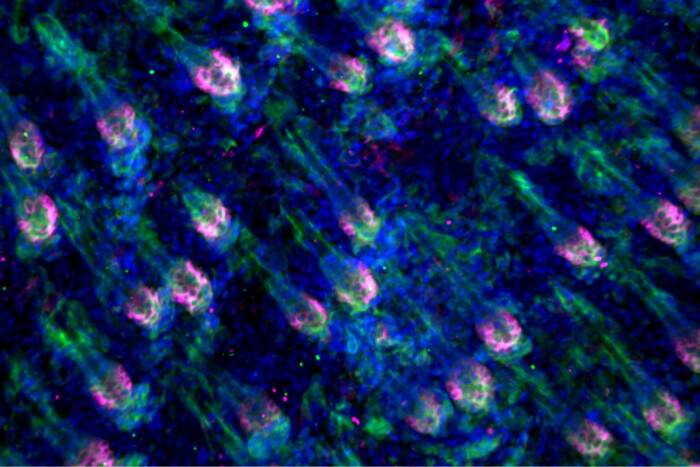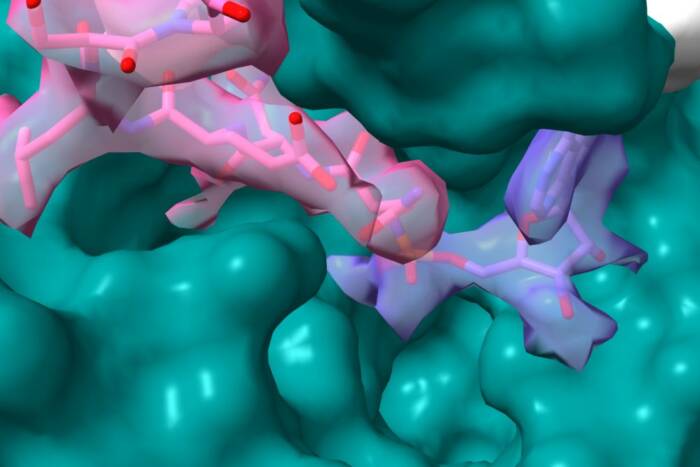Rockefeller University Hospital celebrates 100 years
Later this year, on October 26, the Rockefeller University Hospital will celebrate its 100th birthday. In the century since its founding, more than 100 notable discoveries have been associated with the hospital, research that has bridged the work of physicians and scientists and addressed some of the world’s most pressing public health issues, including infectious and autoimmune diseases, heroin addiction, and AIDS. In recognition of a century of such groundbreaking research, the university is celebrating 2010 as The Rockefeller University Hospital Centennial.
A centennial committee formed last year, chaired by Barry Coller, the hospital’s physician in chief and the university’s vice president for medical affairs, and consisting of personnel from the hospital, Communications and Public Affairs, Development and the Rockefeller Archive Center, has arranged several events to commemorate the anniversary. The first event, a celebration of the 1944 discovery of DNA as the molecule of heredity, took place last February.
This year, there are several symposia, lectures and celebratory events scheduled. The first, to take place in April, will be a research nursing symposium called “Celebrating 100 Years of Research Nursing at The Rockefeller University Hospital,” with a roster of speakers and an exhibit. The hospital has long been a pioneer in the specialty practice of research nursing, in which staff members not only provide care and keep records, but process samples and record data under tightly specified research protocols.
In October, the university will hold a reception for hospital faculty and staff. There will also be a lecture by Sylvia Yount, a curator at The Virginia Museum of Fine Arts, on the hospital’s portrait collection. Finally, on October 29, Eric Lander, founder of the Whitehead/MIT Center for Genome Research, will be the keynote speaker at an all-day Rockefeller University Hospital Centennial Symposium.
To highlight the hospital’s contributions to science — as well as the schedule of events — a special centennial Web site was launched last month. The site contains vignettes describing discoveries associated with the hospital over the years, which can be browsed by research area, investigator or decade. The vignettes were written primarily by Elizabeth Hanson, author of a 2001 book on the university’s history. The site also features a rendering of a commemorative medal designed by Dana Krinsky, a noted medal artist. Visit it at centennial.rucares.org.
Behind the scenes, a process for protecting patients
by TALLEY HENNING BROWN
While 100 years of discoveries get all the attention, a largely below-the-radar committee performs one of the university’s most critical functions and has been doing so for over 35 years. The Institutional Review Board, established at Rockefeller University in accordance with the National Research Act of 1974, is charged with ensuring the safety of the hospital’s most important asset — its patients.
Formal rules regarding the rights of clinical research subjects is a fairly new phenomenon, although many institutions, including Rockefeller, had informal procedures to assure the protection of human subjects all along. In 1972, a spotlight was thrown onto researchers in Tuskegee, Alabama, when a report surfaced that the subjects in a 40-year study on syphilis were not informed about important aspects of their disease and the availability of treatment. The law that took shape over the next two years to protect future subjects of medical research included provisions for Institutional Review Boards (IRBs), committees associated with individual research institutions that are empowered by the government to oversee all clinical studies involving humans.
By law, an IRB must include at least five members, one of whom must be a scientist and another who must be a nonscientist from the institution’s community. Rockefeller’s IRB includes seven scientists, five nonscientists and three alternates who vote when regular members are absent. Those associated with Rockefeller include Emil C. Gotschlich, professor emeritus and chair of the IRB, hospital Pharmacist Johanne Andersen, Clinical Research Officer Rhonda Kost, Professor of Medicine James G. Krueger, hospital Administrative Director Maija Williams, Director of Nursing and Patient Care Services Melissa Offenhartz, hospital Medical Director Barbara O’Sullivan, Associate Professor of Clinical Investigation Sarah Schlesinger and Assistant General Counsel Teresa L. Solomon. Non-Rockefeller members of the IRB include a psychologist, a psychiatrist, an attorney, an Episcopal reverend and Marjorie McCarty, a retired social worker and the widow of former hospital researcher Maclyn McCarty. Rockefeller’s Vernette Owens and Dale Miller run the administrative side of things.
Rockefeller’s IRB reviews dozens of protocols a year and the group is tasked with ensuring more than just participant safety. “We want to make sure our studies meet Rockefeller’s high standards all around,” says Mr. Miller. “We like to see that researchers have been educated in the regulations dealing with human subjects and know how to apply them, but the committee is also involved in helping investigators sharpen their research questions and clarify how they plan to answer those questions in a way that provides accurate data and that is reproducible.”
Of the approximately 140 protocols currently active at the hospital, the majority were reviewed by the IRB as a whole, which requires the presence of at least 50 percent of eligible members plus one to achieve a quorum. About one-third of protocols undergo expedited review, which covers those studies that involve minimal and noninvasive procedures — analyzing existing medical data, for instance. All protocols are approved for no more than one year, after which time a renewal request must be submitted by the principal investigator, a measure enacted to ensure the continued safety of long-term studies.
“Ethical standards have always been of the utmost importance in our work at the Rockefeller hospital,” says IRB chair Dr. Gotschlich. “Making patient care a top priority is what has allowed clinical research to flourish so tremendously at Rockefeller.”
Portraits of Hirsch and Kappas to hang in hospital
by TALLEY HENNING BROWN
 (opens in new window)
(opens in new window)
In the picture. From left, Paul Nurse, Jules Hirsch, Attallah Kappas and Barry S. Coller at the unveiling November 11.
Jules Hirsch and Attallah Kappas, who combined spent 21 years as physicians in chief of the university’s hospital, will now grace it permanently. At an event in November, portraits of the two men painted by Canadian artist Istvan Nyikos were unveiled to a crowd of colleagues, friends and family members. The paintings, commissioned for The Rockefeller University Hospital for its series of physician in chief portraits, now hang in the hospital’s north entrance.
In Abby Aldrich Rockefeller Hall on November 11, 2009, colleagues, friends and family members joined Rockefeller president Paul Nurse and the hospital’s current physician in chief Barry S. Coller at the unveiling celebration. “Kap and Jules played significant roles in sustaining the research programs of the hospital in the 1970s, ’80s and ’90s,” said Dr. Nurse in his opening address to the crowd. “[They] believed that clinical research was essential to progress in biomedicine and that one day it would have a renaissance. And they were right.”
Dr. Kappas came to Rockefeller University on a sabbatical from his post at The University of Chicago on a Guggenheim Fellowship in 1966. An endocrinologist, he wanted to learn more about the interactions of hormones and the liver, and by the end of his research project, he was recruited to stay at the university. He made important contributions to our understanding of heme, the part of the hemoglobin molecule that transports oxygen in the blood and that plays a key role in metabolizing drugs, hormones and environmental chemicals. Dr. Kappas’s work led to advances in the diagnosis and treatment of heme-related diseases, especially inherited acute hepatic porphyria. Recently, he developed a medication currently in late-stage clinical trials to curb neonatal jaundice, a common medical condition of newborns that threatens the central nervous system. Dr. Kappas was physician in chief of the hospital from 1974 to 1991 and vice president from 1983 to 1991, serving under Presidents Frederick Seitz and Joshua Lederberg. Among his numerous contributions was the conception of the Clinical Scholars Program, through which young Ph.D.s and M.D.-Ph.D.s come to the hospital for training in clinical and translational research.
Before a crowd that included his son and daughter-in-law and two grandchildren, Dr. Kappas expressed “how privileged I have been to be here and to have been afforded the opportunities I have had to work both in science and medicine at our hospital.” The portrait of Dr. Kappas was underwritten by a gift from Eugene Lang in honor of his late wife, former Rockefeller trustee Theresa Lang, who died in 2008.
Trained as a cardiologist, Dr. Hirsch came to Rockefeller University in 1954 to conduct research on the metabolism of lipids in the laboratory of Peter Ahrens. He went on to pioneer the field of obesity research, establishing, among other discoveries, that human metabolism will adjust itself to maintain a set weight, one reason why weight loss can be so difficult for so many. Dr. Hirsch was physician in chief of the hospital from 1992 to 1996. In addition to winning renewal of the General Clinical Research Center grant — the precursor of the National Institutes of Health’s Clinical and Translational Science Award — he ensured the continued success of the Clinical Scholars Program by spearheading fundraising efforts to endow it.
“I always expected that if I were ever to do something of note, my face would end up in the Post Office on a ‘Wanted’ poster,” said Dr. Hirsch, who went on to describe the experience of his father, an Eastern European immigrant who watched The Rockefeller University Hospital being built and opened in 1910. “Rockefeller is my family, this has been my intellectual home. So whatever comes in the next century, I’ll be ‘hanging around.’”
The two portraits now hang in the entrance to the hospital, along the north wall.


